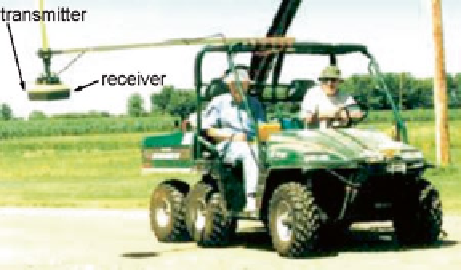Agriculture Reference
In-Depth Information
Fig. 5.19
Sensing surface
reflectance of ground
penetrating radar (From
Redman et al.
2003
, altered)
This is probably the deepest sensing that can be realized in the radar surface reflec-
tance mode presently. Some farming operations and irrigation methods might ben-
efit from control procedures that were based on such a depth. However, the
equipment that is used for this mode of land based on-the-go surface reflectance
sensing still is rather clumsy and not available commercially.
Principally there is no reason why sensing of radar reflectance - if it occurs from
land vehicles instead of from satellites - should not have to cope with the influence
of soil surface roughness on the signals. However, a general experience is that the
effect of
surface roughness
on the signals decreases when the wavelength increases
(Paul and Speckmann
2004
). This would imply that as a result of the longer wave-
lengths that are used, the land based sensing as outlined above should have less to
deal with surface roughness.
Yet results that have been obtained so long do not indicate that this problem
therefore has gone. The raw signals that were recorded via Topp's equation
(Sect.
5.2.3.1
, last part) when operating in a grassy field and silt loam soil reveal
more variability than would be expected from the water situation (Fig.
5.20
). It is
suspected that despite the longer wavelengths, at least part of this excessive vari-
ability is due to surface scattering of the reflected radiation. In order to make up for
this, means of ten adjacent signals respectively were generated by applying a simple
moving averaging filter. The thus obtained curve of the means seems to provide
reasonable estimates although the question of biased results arises.
The black points represent results from time domain reflectometry. The estimates
obtained with this method are generally presumed to be accurate and can hardly be
influenced by surface roughness, which is also suggested by their course (Fig.
5.20
).
5.2.3.4
Water Sensing from Farm Machinery by Capacitance
This method needs galvanic contact with the soil, similar to the electrical conductiv-
ity method in Fig.
5.3
. But contrary to this conductivity sensing method, the positive
and negative electrode are positioned very close to each other,
e.g.
within the same
cultivator tine.

